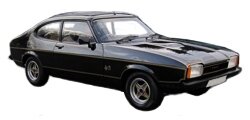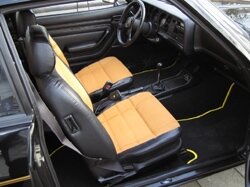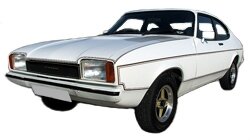Model Page
Capri Mk II John Players Special

|
Production Run: |
2,003 |
|---|---|
|
Production Date: |
March 1965 - October 1975 |
|
Engine: |
1,593cc Ford Pinto OHC 1,993cc Ford Pinto OHC 2,994cc Ford Essex V6 |
|
Built: |
Ford - Halewood (UK) |
|
0-60: |
1.6 - 13.5 Secs 2.0 - 11.1 Secs 3.0 - 9.0 Secs |
|
Max Speed: |
1.6 - 106 Mph 2.0 - 108 Mph 3.0 - 122 Mph |

Introduced in March 1975, the John Players Special Capri was a limited edition Capri produced with the intention of re-introducing some sparkle to the Ford Capri range. The JPS Capri capitalised on the success of the Lotus Formula 1 racing team that raced in the same black with gold stripes coachworks, oddly the model was never officially called the John Players Special Capri and was in fact the Capri Midnight S./p>

Black JPS Capri
Introduced in 1974, the Mk 2 Capri was wider, heavier and softer than the outgoing Mk 1 Capri, sporting a rear hatchback the car was designed to be more practical, addressing the first models main failing. Launched during the fuel crisis to a public that was becoming increasingly interested in smaller, more efficient cars, sales of the models quickly began to slide.
At the time the top of the range Capri was the 3.0 Capri GT, Uwe Bahnsen was tasked with generating more interest in the Capri line-up. The new model was developed from the Capri Mk 2 GT, the decision was taken to follow in the steps taken by Porsche in the early seventies whereby all chrome trim was replaced by matt black items.

Rear Shot
Codenamed “Midnight” the car was a standard Capri Mk 2 but all exterior chrome-work was removed, the items being replaced with items coated or painted in black. The door handles, bumpers, windows mouldings, wing mirrors and exhaust tail pipe were all replaced with black items. The JPS Capri’s paintwork was finished in midnight black, the prototype was displayed and was criticised for being “So black you couldn’t see it”. To lift the appearance gold striping was added outlining the body panels, the exterior package was completed with tinted windows and similar to the Lotus F1 cars the European model cars received gold painted four spoke alloy wheels, US spec cars only received gold coloured steel wheels.
The all black theme was continued throughout to the cars interior, the seats were taken from the Capri GT but were trimmed in black vinyl with gold coloured Rialto cloth inserts, even the headlining was coloured black. The standard steering wheel was replaced with a three spoke item that had a unique gold centre cap to distinguish the model from it's lesser cousins.
Interestingly the JPS was also available in white, the exact opposite to the midnight Capri. The White Capri JPS had all chrome work and external trim (with the exception of the front grill) replaced with items painted in white, the car retained the gold coach lining, the same interior and alloy wheels as the black car. Approximately 25% of the JPS model production run were finished in white.

JPS Unique Interior
The car retained the same mechanicals as the Capri GT but in line with German tastes the car received upgraded suspension through the installation of a firmer set of Bilstein dampers fitted along with a thickened front anti roll bar thus giving the Mk II Capri a much needed sportier ride.
The car was available with a choice of three engine options, namely the Pinto overhead camshaft 1.6 four cylinder engine, the 2.0 Pinto engine or topping the range the Essex 3.0 V6. The 1.6 engine benefited from the GT spec and therefore was equipped with a Weber 32/36DGV twin choke carburettor, with a bore and stroke of 87.67mm x 66mm the power plant had a capacity of 1,593cc and had a compression ratio of 9.2:1. The engine produced 88 bhp @ 5,700 rpm and 92 lb/ft @ 4,000 rpm, in this guise the car was capable of reaching sixty miles per hour from rest in around 13.5 seconds, powering on to a top speed of 106 Mph.
Common with the 1.6 unit, the 2.0 Pinto equipped model received GT specification, with a bore and stroked of 90.8mm x 76.9mm the engines capacity was 1,993cc and again had a 9.2:1 compression ratio. The engine was fed through a Weber 32/36 DGV twin choke carburettor and developed 98 bhp @ 5,200 rpm and 112 lb/ft @ 3,500 rpm. This unit gave the car significantly improved performance figures with the zero to sixty spring taking 11.1 seconds and on to a top speed of 108 Mph.

Ultra rare white JPS Capri
Topping the range was the Capri JPS 3.0, powered by the 2,994cc Essex V6, the engine had a bore and stroke of 93.66m x 72.44mm. With a compression ratio of 9.0:1 and a Weber 40 DFAV twin choke carburettor that was latterly replaced with the Weber 38/38 EGAS carburettor the engine developed 138bhp @ 5,100rpm and 174 lb/ft @ 3,000 rpm. This helped make the car amongst the fastest cars produced by Ford Europe at the time with a top speed of 122 Mph and 0-60 in 9.0 seconds.
Mechanically the car retained the manual four speed gearbox, optionally owners could chose a three speed automatic C3 gearbox. Again, in common with the rest of the range the car used the same MacPherson strut, rear multi leaf spring suspension configuration. Braking was courtesy of a front disc / rear drum servo assisted braking setup – these being carried over directly from their equivalent GT models.
The car was launched at the Geneva Motorshow in March 1975 and became immediately popular with press and public alike, initially only available as left hand drive the right hand drive car did not get released in the UK until June 10th. Such was the popularity of the model with customers and the positive press reaction Ford decided that the model would no longer continue as a limited edition, the Capri Midnight was replaced in October 1975.
The Facts
|
Engine: |
1.6 Pinto Four Cylinder Overhead Cam 2.0 Pinto Four Cylinder Overhead Cam 3.0 Essex V6 |
|---|---|
|
Capacity: |
1.6 - 1,593cc 2.0 - 1,993cc 3.0 - 2,994cc |
|
Valves: |
1.6 - 8 2.0 - 8 3.0 - 12 |
|
Compression Ratio: |
1.6 - 9.2:1 2.0 - 9.2:1 3.0 - 9.0:1 |
|
Fuel System: |
1.6 - Weber 32/36 DGV Twin Choke Carburettor 2.0 - Weber 32/36 DGV Twin Choke Carburettor 3.0 - Weber 40DFAV Twin Choke Carburettor / Weber 38/38 EGAS Carburettor |
|
Maximum Power: |
1.6 - 88bhp @ 5,700 rpm. 2.0 - 98bhp @ 5,200 rpm. 3.0 - 138bhp @ 5,100 rpm. |
|
Maximum Torque: |
1.6 - 92lb/ft @ 4,000 rpm. 2.0 - 112lb/ft @ 3,500 rpm. 3.0 - 174lb/ft @ 3,000 rpm. |
|
Transmission: |
Manual 4 Speed / C3 3 Speed Automatic |
|
Top Gear: |
1.6 - 18 Mph / 1000 rpm 2.0 - 19.5 Mph / 1000 rpm 3.0 - 21.9 Mph / 1000 rpm |
|
Brakes: |
Servo Assisted Front Discs / Rear Drums |
|
Kerb Weight: |
1.6 - 1055 Kg 2.0 - 1055 Kg 3.0 - 1170 Kg |
|
Max Speed: |
1.6 - 106 Mph 2.0 - 108 Mph 3.0 - 122 Mph |
|
0-60: |
1.6 - 13.5 Secs 2.0 - 11.1 Secs 3.0 - 9.0 Secs |






